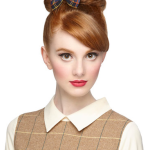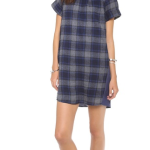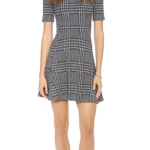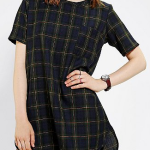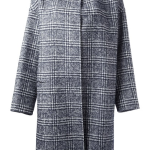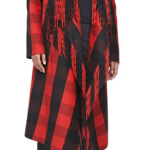Blog
Winter Project Idea: Fleece Fabric Scarves
If you’re stumped on what crafty/creative/sentimental presents to get your loved ones this holiday season, I’m pretty sure I have an awesome solution for you. Fleece fabric. It’s super cuddly, easy to work with and apropos for this time of year.
While it’s simple to cut long strips out of a couple yards of fleece for some no-sew scarves (yay for clean fray-free cuts!), the edges are where you can really take things up a notch. Bust out your serger for a straight finish, or use it to create a lettuce edge like I showed you here. Hand sewing with a blanket stitch would also be a beautiful solution. Here’s a great video tutorial if you need a refresher.
Now for the fun part! Let’s go over some ideas to make each fleece fabric scarf unique:
1. Double up with two different colors or prints. Maybe plaid on one side, with a solid color on the other.
2. Sew on some tassels or fringe.
3. Or simply cut tiny strips in the edges for fleece tassels.
4. Embroider someone’s initials or perhaps a cute word like “love.”
5. Go for the unexpected! Fleece polka-dots are one of my faves.
6. Sew the ends together to make it an on-trend infinity scarf.
7. Or cut out cute hearts, dolphins, owls, to applique on the ends (great for the little ones!).
Here are a couple darling fleece scarves I made for some inspiration. Enjoy!
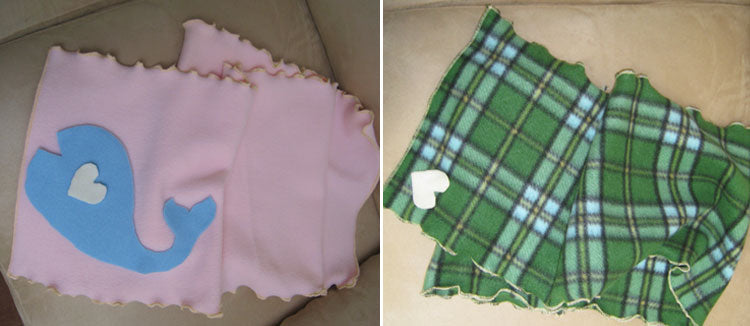
Jump in on the Plaid Fabric Trend
Believe it or not, fashion is all about plaid fabric right now. From lumberjack flannel to ladylike checkers, street stylers and red carpet walkers alike are eating it up. So guess what, I’m going to supply you with the easiest ways to infuse the trend into your wardrobe (with a little help from your sewing machine, of course).
Easy Accessory Design Ideas:
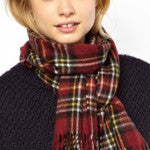
1) A scarf. It doesn’t get any simpler than a neckwarmer for sewing. Choose a plaid fleece fabric for a quick no-sew project. Just buy a couple yards and cut them into strips to keep all those on your shopping list cozy. A once-around stay stitch will give a cool effect to fray-happy fabrics.
2) A hair bow. This is so girly you could make it for your niece or put it in your hair for a retro kick next time you wear your favorite sheath. Pick any pattern you like and utilize that fray check.
3) A beanie. Find the stretchiest of plaid to make a quick (and warm!) slouchy hat for snow play days.
Easy Dress Design Ideas:
1) A plaid shift. It sounds obvious, but to keep the sewing of plaid simple, opt for simple shapes like a boxy shift dress. Seams will be a breeze to match without risking a jarring uneven lineup at your side. Plus, it’s very mod and can be easily belted to show your figure.
2) Want a tighter fit? Nip it at the waist and finish with an A-line flare.
3) Make a shirtdress. Grab a T-shirt from your drawer and base your design off of it, merely lengthen the pattern to create this laid-back easy to replicate vibe.
Coats (my favorite!) may seem daunting, but there are just three rules to follow to streamline your design:
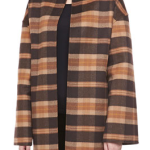
1) Choose boxy fits—another big trend right now!
2) Go collarless. We all know what a headache collars are to construct, right?
3) Forgo hardware or closures. Waterfall necklines sans buttons are so chic! And you can always add a belt for windy days. Just be sure to choose a plaid that’s as beautiful on the inside as it is on the out.
So how are you going to join the plaid fabric trend this season?
Sewing Flattering Stripe Fabric
Often, stripe fabric is avoided due to the fear of widening horizontal lines or the bold eye-catching nature of the graphic print. I’m here to tell you, however, that stripes are our friends.
Why?
1) Nothing is more classic. From Audrey Hepburn to Brigitte Bardot, they’ve stood the test of time.
2) They’re surprisingly versatile. Just ask J.Crew: They can be preppy or cozy, edgy or polished.
3) They are flattering. When used for good and not evil (guidelines below).
How?
1) You can never go wrong with vertical lines. They’re lengthening and slimming, I promise.
2) Test out diagonals. Often forgotten, the diagonal stripe can add an interesting edge to any design. I was particularly inspired by this luxe poncho with what looks to be excitingly easy construction.
3) Get loose. Stripes get risky when they hug too tight, but loosely fitted sweaters and blouses like this have just the right cool and comfortable vibe.
4) Go with basic colors. If you fear a headache from your latest creation, stick to black-and-white, nautical navy or neutrals.
5) Have fun! Glam up a basic with unexpected embellishments like sequins for an evening-worthy result.
What do you think? Are you feeling inspired to take on a stripe fabric project? Odds are it’ll be something you can keep around for quite a while.
Houndstooth Fabric Heaven
I keep no secret of the fact I go nuts for classic fabrics, particularly in the coat department. So as temperatures continue to drop (and after a brutal day of hurricane winds at the pumpkin patch with my niece), I’m seriously on the hunt for some timeless winter inspiration. More specifically, I have my eye on anything and everything with houndstooth fabric. Dresses, skirts, blazers, scarves—you name it, I want to make it.
Fortunately, ‘tis the season for the two-tone checkers to thrive. After digging around for ideas from the world of internet shopping, I found some share-worthy favorites. They’re on-trend and fairly uncomplicated to replicate, with your own spin, of course.
 It doesn’t get much more mod than a houndstooth shift dress. What I love about this Mango design (aside from the forgiving shape) is the heavy neck and armhole binding. It breaks up the pattern nicely and would give a charming finish to any piece. I imagine wearing this with black tights and ballet flats for a day at the office.
It doesn’t get much more mod than a houndstooth shift dress. What I love about this Mango design (aside from the forgiving shape) is the heavy neck and armhole binding. It breaks up the pattern nicely and would give a charming finish to any piece. I imagine wearing this with black tights and ballet flats for a day at the office.
 Now, if you want to truly dive into Mary Quant territory, a miniskirt a la Marc Jacobs will do the trick. Make sure to buy some knee-high socks for this baby.
Now, if you want to truly dive into Mary Quant territory, a miniskirt a la Marc Jacobs will do the trick. Make sure to buy some knee-high socks for this baby.
 However, if you prefer to go pre-miniskirt era with a little ‘50s style, look no further than Dolce & Gabbana. I’d really love a herringbone dress with a fit-and-flare silhouette hanging in my closet, but at a lower price point courtesy of my sewing machine.
However, if you prefer to go pre-miniskirt era with a little ‘50s style, look no further than Dolce & Gabbana. I’d really love a herringbone dress with a fit-and-flare silhouette hanging in my closet, but at a lower price point courtesy of my sewing machine.
 This Theory cocoon coat is another winner in my book. It offers a tailored look without needing a sternly tailored pattern due to its drop-sleeves and oversized build.
This Theory cocoon coat is another winner in my book. It offers a tailored look without needing a sternly tailored pattern due to its drop-sleeves and oversized build.
 If you’re just looking for a fun project, on the other hand, or perhaps some holiday gift ideas, check out the beautiful simplicity of Zara’s frayed neck warmer. All you have to do is order the proper yardage of houndstooth fabric, cut a long rectangle, sew a single “stay stich” one inch inside the parameter, then fray the edges with your fingers. Easy peasy!
If you’re just looking for a fun project, on the other hand, or perhaps some holiday gift ideas, check out the beautiful simplicity of Zara’s frayed neck warmer. All you have to do is order the proper yardage of houndstooth fabric, cut a long rectangle, sew a single “stay stich” one inch inside the parameter, then fray the edges with your fingers. Easy peasy!
5 Unique Ways to Use Pinstripe Fabric
I’ve always thought pinstripe fabric was reserved for office suits, blazers and pencil skirts—but there are some new fashion trends that are making me think again. I gathered five unique approaches to the sophisticated fabric that may just make you think outside the lines, as well.
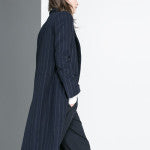 1. A Pinstripe Coat
1. A Pinstripe Coat
Sure, those little tailored jackets that perfectly match your pants are nothing new, but this pinstripe coat from Zara is an entirely different idea. It has a tough edge and manages to look impossibly cool with cropped pants and ankle-boots. Plus, it’s way warmer than your go-to blazer.
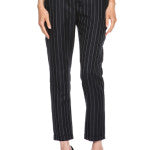 2. Pinstripe Draw-String Pants
2. Pinstripe Draw-String Pants
Yes, you read that right. I’m talking drawstring pinstripes. I loved Stella McCartney’s clever combination of the meeting-worthy motif with a cozy jogging fit. Cuts down on a lot of complex construction pressure, too, doesn’t it?
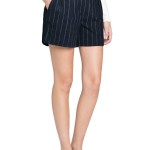 3. Pinstripe Shorts
3. Pinstripe Shorts
It’s no longer summer, but a proper pair of shorts like these would look both business appropriate and super stylish when worn with tights and pumps. Bonus points if you make a matching topper for a darling short-suit.
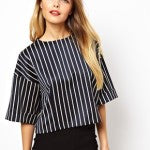 4. A Boxy Pinstripe Tee
4. A Boxy Pinstripe Tee
A basic top like this ASOS shell is not only a breeze to make, it’s a great way to funkify the classic pattern. Lengthen the sleeves or lower the neckline, just hold onto that boxy fit for a street styler vibe.
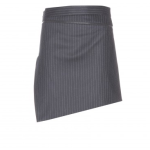 5. An Asymmetrical Skirt
5. An Asymmetrical Skirt
If pinstripes are all about being orderly, mix things up with an asymmetrical hem like this Salvatore Ferragamo wool skirt. This can be applied to blazers, blouses and shirtdresses to give things an artistic touch.
Chime in! Which creative pinstripe fabric style is your favorite?
Velvet Fabrics with Retro Inspiration
It may only be October, but the holidays will be here in the blink of an eye. Meaning? It’s time to get a jump on sewing those formal gowns, party dresses and maybe a darling frock or two for the little girl in your life.
Perhaps the fabric most closely linked to winter months—aside from flannel and fleece—is velvet fabrics. Its distinct luxurious texture lends itself flawlessly to fancy occasions. And no, it’s not just a thing for ‘80s hair bands (though Katy Perry is doing her best to bring that look back). If you’re hunting for timeless evening inspiration, turn to Marilyn Monroe sheath dresses or Audrey Hepburn fit-and-flares.
My favorite place for this kind of inspiration is the online vintage marketplace Etsy.com, where you’ll find endless authentic ideas you know will stand the test of time. Take a look at this grass green floor-length number with a bowed waist and short sleeves, and this LBD with a winged neckline, or this simple scarlet wiggle dress. You can even use the fabric as a glamorous trim for a collar or a bow. See? Endless ideas! Heck, you can even find a plethora of original vintage patterns to use or customize.
Once you choose your design, here are three techniques you should keep in mind while working with velvet:
- Keep a consistent direction. It may sound obvious, but velvet fabric has a directional nap to it so you’ll need to place all your pattern pieces with the tops on the same side. You can choose to have the nap go up or down, you’ll just need it to be consistent.
- Buy extra fabric to account for the pattern piece placement. Since you won’t be able to squeeze together your pieces in any direction you choose like a puzzle, you’ll need more yardage than you think.
- Velvet is slippery, and pins can often leave unsightly dents. You’ll want to hand baste prior to machine stitching to be safe. Heaven forbid you have to seam rip through that pile!
Bonus tip: If you crush the fabric, steam it with a steamer or hang it in shower to get it back to its original shape!
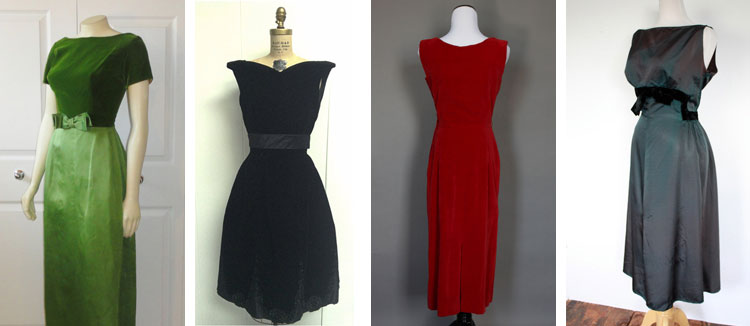
Designing With Denim Fabrics
With the ’90s revival in full force, it shouldn’t surprise you that denim fabrics are everywhere right now. And I’m not just talking blue jeans! From chambray button-ups to shirtdresses and skirts, the heavy-duty fabric is actually quite versatile. While we all tremble in horror at the memory of Justin and Britney’s matching denim suits, there is a way to get design-happy with the on-trend fabric while not going overboard.
Here are some tips that promise chic results with denim fabrics:
1. Go for simple silhouettes.
This T-shirt dress from TopShop is a prime example, not to mention it’s so very Alexa Chung in its street style savvy. Plus, how easy would this be to sew? You’d hardly need a pattern.
2. Remember, little details go a long way.
Check out the simple ruffle on this ASOS dress. It’s minimal while making a big impact due to the weight of the textile. In other words, there’s no need to get intricate, pick a focal point and try pleats, pintucks, or gathers for standout results.
3. Don’t forget, denim can be delicate.
This fitted Modcloth top demonstrates just that all while sticking to the aforementioned rules. There’s nothing heavy about it, it’s flirty and feminine.
4. You don’t have to stick to plain blue.
Denim comes in fun prints like this Shop Ruche dress, it can be bright red or pastel pink, bleached or stonewashed black.
5. Try unconventional designs.
Jeans and jean jackets might be your first instinct, but they’re a dime a dozen in stores and a huge constructional feat. Think outside the box with sweet circle skirts, or even nostalgic pinafores (remember what I said about that whole ‘90s thing?).
6. Use denim accent pieces.
Sleeves, pockets, collars and cuffs can all be made to contrast your main fabric. This cashmere sweater joins soft with structured in one of the most unique ways possible.
What do you think, will you be infusing denim into your future creations?
Making Animal Print Fabric Chic
We’ve all seen it, animal print fabric can range from frightfully tacky to amazingly stylish. So what are the defining elements of success? How do we avoid Snooki and shoot for Heidi Klum? And how do we implement this into our next creations?
There are three rules for success: classy cuts, classy lengths and classy fits. Leopard print takes on a whole new personality when it’s in the form of a tight body-con dress versus a sleek sheath.
Here are five key things to keep in mind:
1. For dresses or skirts, choose patterns with hemlines no shorter than a few inches above the knee.
2. If you pick a stretchy fabric, allow some extra comfort room to avoid any cling.
3. Opt for sleeves—either cap, ¾ length, or full will make your dress or top office-to-cocktail appropriate.
4. Try draping! Elegantly draped, pleated or layered fabric automatically has a high-end feel.
5. Keep accessories in mind. Belts, statement necklaces, embellished purses and even tights have the power to up the style ante.
Here are some examples of supremely elegant animal print fabric in stores now:
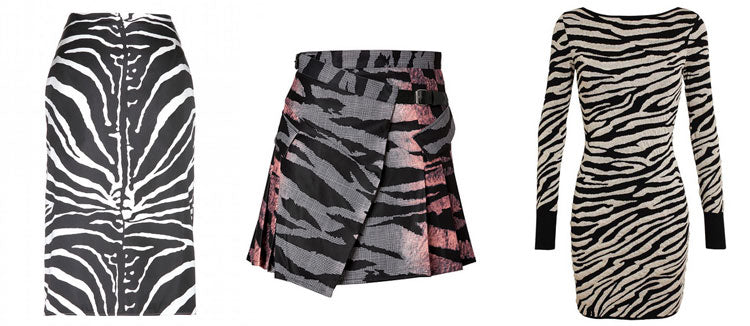
So what’s the verdict, are you going to give the wild trend a go?
Sewing Sheer Fabric: How to Create a French Seam
I’ve always been drawn to the ethereal look and feel of transparent textiles, be it organza, chiffon, or a delicate rayon. They hold so much potential, from dreamy eveningwear with floating trains to sophisticated blouses layered over camisoles. But, admittedly, it takes a bold soul to bring them to a sewing machine.
Since the final product is, well, see-through, every part of your construction must be flawless. No pressure! Fortunately, there’s a go-to technique that will get you beautiful results inside and out: French seams. It’s basically a seam with a casing on the inside to hide any raw edges. In fact, sometimes I even use this tactic on fabrics that aren’t sheer, just to get a professional finish.
How to do it:
Step 1: Factor in extra seam allowance for your pattern. Generally, this means you will double your standard seam allowance, then add ⅛” of an inch to that. Yes, it takes slightly more of your precious fabric, but is totally worth it.
Step 2: Face the wrong sides AKA the insides of your fabric pieces together and sew your standard seam allowance. This will look, at first, as if the seam is on the outside of the garment.
Step 3: Trim off any seam excess, but don’t get closer than ¼” to the sewing line.
Step 4: Iron the right sides AKA the outside of your fabric pieces together.
Step 5: Sew a second seam encasing the original.
Viola! You have a flawless closure to any unsightly interior seams, making sheer fabrics a breeze to work with. Bonus: This trick is especially helpful for any fabric with the tendency to fray like crazy.
For a visual, check out this super helpful Youtube tutorial.
Take a look at these gorgeous high-end items on the market now that utilize this technique:
Creative (Stylish!) Designs With Cotton Flannel Fabric
Cotton flannel fabric is generally reserved for cuddly pajamas—cue those winter time memories of hot chocolate by the fire—but this year the fabric is getting a makeover.
As summer neared an end, we started to see a heavy dose of plaid in stores and on the most fashionable celebrities (think Gwen Stefani and Victoria Beckham). Then New York Fashion Week came in a flurry and delivered more inspiration for the classic print. In other words, there’s no better time to cozy up to some cotton flannel fabric for both your high-style and low-key apparel needs.
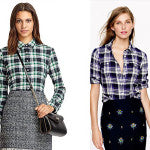 A simple button-up can be paired with a tweed skirt for an office-worthy ensemble like these sets from Brooks Brothers and J.Crew.
A simple button-up can be paired with a tweed skirt for an office-worthy ensemble like these sets from Brooks Brothers and J.Crew.
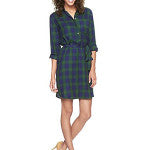 Lengthen that pattern to create a blousy shirtdress like this tie-waist number from GAP. Wear it with boots for a cute country twist or brown ballet flats for a city-chic feel—it could easily become your errand-running weekend staple.
Lengthen that pattern to create a blousy shirtdress like this tie-waist number from GAP. Wear it with boots for a cute country twist or brown ballet flats for a city-chic feel—it could easily become your errand-running weekend staple.
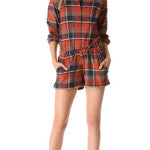 And who doesn’t love the no-fuss fabulosity of a one-piece like this Harvey Faircloth romper? The brilliance of this (aside from the total avoidance of having to think about matching in the morning) is it can be pulled off by you or made micro for your niece.
And who doesn’t love the no-fuss fabulosity of a one-piece like this Harvey Faircloth romper? The brilliance of this (aside from the total avoidance of having to think about matching in the morning) is it can be pulled off by you or made micro for your niece.
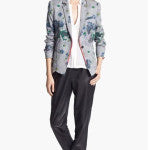 But hey, let’s not forget that cotton flannel doesn’t only come in the form of lines and checkers. This floral Elizabeth and James blazer breaks all the rules and voids any preconceptions about the limitations of the fabric. You can get even more creative by mixing and matching prints and textures like this Free People top.
But hey, let’s not forget that cotton flannel doesn’t only come in the form of lines and checkers. This floral Elizabeth and James blazer breaks all the rules and voids any preconceptions about the limitations of the fabric. You can get even more creative by mixing and matching prints and textures like this Free People top.
So when you’re stocking up on your cold weather fabrics this round, keep these fun all-season ideas in mind, especially the cotton flannel fabric!
That ‘70s Style Corduroy Fabric
If you adore vintage clothing as much as I do, you probably also have an affinity for corduroy fabric. GAP brings back the trend every few years, but it doesn’t have quite the same retro vibe on a pair of skinny jeans. The touchable textile looks cutest in the silhouettes of the ‘60s and ‘70s—I’m talking pinafores and bell-bottoms.
That being said, it’s also important it feels modern and not even slightly costume-y. Fortunately, my internet shopping skills discovered some totally wearable non-Halloweeny implementations of the textured fabric.
 First up: Free People’s flares. I adore the saturated mulberry and evergreen hues! Bring out your inner boho babe like Vanessa Hudgens or Nicole Richie by creating a similar look. Long layered pendant necklaces would take things to the next level.
First up: Free People’s flares. I adore the saturated mulberry and evergreen hues! Bring out your inner boho babe like Vanessa Hudgens or Nicole Richie by creating a similar look. Long layered pendant necklaces would take things to the next level.
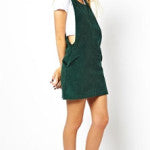 More into the mod movement than the hippie fest? ASOS’ cord dress with a simple A-line silhouette will make you flip. Darling, right?
More into the mod movement than the hippie fest? ASOS’ cord dress with a simple A-line silhouette will make you flip. Darling, right?
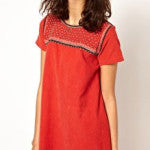 And don’t be afraid to try some embellishments on the rich fabric, some beading or embroidery will give any item extra depth and an authentic vintage look. This shift dress from Paul and Joe Sister is an excellent example of just that.
And don’t be afraid to try some embellishments on the rich fabric, some beading or embroidery will give any item extra depth and an authentic vintage look. This shift dress from Paul and Joe Sister is an excellent example of just that.
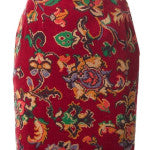 The easiest way to break into using corduroy fabric, however, is with a skirt like this can’t-look-away Kenzo creation or this sweet high-waist circle design from Urban Outfitters. These would be basic yet unique pieces to add to your wardrobe.
The easiest way to break into using corduroy fabric, however, is with a skirt like this can’t-look-away Kenzo creation or this sweet high-waist circle design from Urban Outfitters. These would be basic yet unique pieces to add to your wardrobe.
Are you a fan of corduroy fabric? Do you have a favorite cord item from your closet’s history?
Two Easy Tricks for Beautiful Knit Fabric Hems
When it comes to sewing with knit fabric, you either love it or hate it. Fortunately, I’m in the first camp. In fact, I learned to sew in high school using stretch fabric that I would drape and pin on myself to make my homecoming and prom dresses. And I have to say—despite my lack of formal training—the results were pretty fantastic. I loved how forgiving it was in the fit department, if I made my gown a wee bit too small no one would be the wiser, not even myself. Anything woven, on the other hand, would have told a different (probably Frankenstein-y) story.
One of the first steps to conquering the pliable textile is to work with its unruly behavior. Often, it’s a battle to hem a knit dress, but luckily when you stop fighting it, the outcome is quite beautiful. This particular trick works best with a serger, but will also work with a regular sewing machine. While hemming, simply pull the fabric lightly and you will create a lovely lettuce leaf effect that’s perfect for scarves or whimsical frocks. Try it with a strip of fabric to see what I mean. Note: The harder you pull the more intricate the curled edges will be, but don’t pull so hard you break your needle!
Not a fan of the effect and hoping for a streamlined finish? Don’t fret, there’s a simple solution for that, too. Hit up your nearest gifty retailer and stock up on tissue paper. Next time you’re about to face off with a slippery neckline or armhole all you have to do is place a sheet under the fabric. It’s seriously miraculous. Bye-bye wonky uneven edging!
Soon, you’ll fall in love with that stretch as much as I have! If you’re looking for inspiring ways to test out your skills, first take a look at these fab fabric options, then turn to the queen of knits: Diane von Furstenberg. Here are a few of my recent favorites from her collection:
Swoon-worthy, right?



